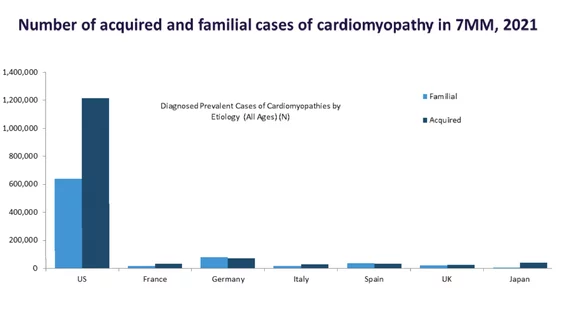U.S. expected to see large rise in cardiomyopathy cases over next decade
A new healthcare market report projects the United States will see a major increase in new cardiomyopathy cases in coming years, possibly reaching more than 2.3 million by 2031. The authors of the report said hospitals should consider the information when planning for future needs in their cardiology departments.
Cardiomyopathy is a general term for a collection of diseases that affect the heart muscle. The walls of the heart are thickened (hypertrophied), reducing its ability to pump blood. Risk factors range from family history to diabetes, alcohol consumption, obesity and high blood pressure. The main forms of cardiomyopathy are dilated cardiomyopathy (DCM), hypertrophic cardiomyopathy (HCM), restrictive cardiomyopathy (RCM) and arrhythmogenic right ventricular cardiomyopathy (ARCM).
Hypertrophic cardiomyopathy often goes undiagnosed because many people with the disease have few, if any, symptoms, according the Mayo Clinic. However, in a small number of people with HCM, the thickened heart muscle can cause shortness of breath, chest pain or changes in the heart's electrical system, resulting in life-threatening irregular heart rhythms (arrhythmias) or sudden death.
The new report projects the vast majority of the new cases will be DCM and HCM.
Healthcare market research firm GlobalData reports in its new report "Cardiomyopathies Epidemiology Analysis and Forecast, 2021-2031" that the U.S. will have significantly higher numbers of cases than any of the other seven major market (7MM) countries. The 7MM include the U.S., Japan and the EU countries of France, Germany, Italy, Spain and the U.K.
The report projects the U.S. will represent 83% of the total cases in the 7MM, with the next closest countries being Germany (5.7%) and Spain (2.9%). .
“Even if we compensate for the differences in population size, the U.S. is still miles ahead when it comes to total cardiomyopathy cases," explained Walter Gabriel, MPH, an epidemiologist at GlobalData, said in a statement about the report. "In a way, this is no surprise. The number of type II diabetes cases in the U.S. is expected to annually rise by 1.8% to over 20.8 million cases by 2028, while high blood pressure is also expected to annually rise by 0.95%, from to over 65 million diagnosed cases in 2027. These are key risk factors for cardiomyopathy."
Gabriel said the U.S. has had challenges with obesity and other metabolic diseases. He said this report should be a warning about unhealthy lifestyles and the impact they will have on the healthcare industry.
Another contributing factor to the U.S.’s high numbers is the lack of robust epidemiological data. “When forming our report, we found that epidemiological data pertaining to these specific forms of cardiomyopathy were incomplete for many markets, therefore we had to assume that the ratio of cardiomyopathy subtypes were similar between markets with missing data. This resulted in the U.S. having many additional cases of cardiomyopathy due to its high prevalence of HCM," Gabriel explained.
Acquired cardiomyopathies expected to outpace familial cardiomyopathies
The U.S. is also expected to see the split between familial (inherited) and acquired cardiomyopathies (where the patient develops cardiomyopathy as a result of another condition or factor) rise, in stark contrast to nearly every other country in the 7MM. The U.S. proportion of acquired cardiomyopathies is double that of inherited, whereas in the rest of the 7MM is broadly an even split.
“The high proportion of acquired cases of cardiomyopathy in the U.S. may be attributed to a high number of individuals engaging in lifestyle factors that place them at a higher risk of developing cardiomyopathy," Gabriel said. "These factors include, but are not limited to, diet, drinking alcohol and a lack of exercise.”
The report includes a 10-year epidemiological forecast for the diagnosed prevalent cases of cardiomyopathies segmented by subtype, sex and age in these markets. The diagnosed prevalent cases are further segmented by causes (acquired versus inherited) and ischemic cases (DCM only).
Complications of hypertrophic cardiomyopathy
HCM can cause atrial fibrillation (AFib), blocked blood flow, mitral valve disease, dilated cardiomyopathy, syncope and sudden cardiac death.
While rare, hypertrophic cardiomyopathy can cause heart-related sudden death in people of all ages. Since many people with do not realize they have HCM, sudden cardiac death might be the first sign of the condition.
Related Cardiomyopathy Content:
FDA approves mavacamten for obstructive hypertrophic cardiomyopathy
AI-powered ECG analysis could boost care for patients with hypertrophic cardiomyopathy
Metoprolol demonstrates value as a treatment for obstructive hypertrophic cardiomyopathy
Diabetes with cardiomyopathy associated with heightened heart failure risk
‘Surprising’ trends in ICD use among HCM patients
Combined genetic testing for cardiomyopathies and arrhythmias yields positive results
COVID-19 leads to sharp rise in stress cardiomyopathy
LAA occlusion reduces stroke risk among patients with HCM and AFib
MRI detects heart failure risk in patients with dilated cardiomyopathy

